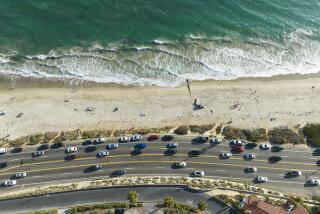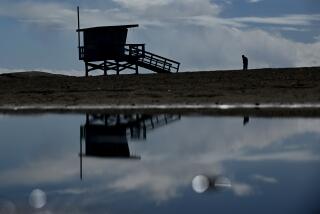Sewage System Failures Probed
- Share via
Los Angeles County sanitation officials said Monday that they were unable to explain a chain of failures that led to what they are calling the largest sewage spill into Santa Monica Bay in a decade.
About 2 million gallons of untreated sewage spewed out of manhole covers and some residential pipes Sunday after a power failure shut down a pumping station in Manhattan Beach.
Nearby beaches will remain closed for days.
A day after the spill, the reason for the power outage remained a mystery: The station, which is supposed to pump raw sewage to a treatment station in Carson, has connections to Southern California Edison lines as well as a backup generator, but all of them failed.
An alarm system is supposed to warn the Los Angeles County Sanitation Districts when the pumping station shuts down, but it also failed.
Not until an hour later did officials sense that something was wrong -- they discovered that the alarm systems at about 21 pumping stations were not communicating with the central alarm center.
More hours passed before officials could take effective steps to stop the sewage flow.
Ultimately, about 100,000 gallons of sewage flowed into the Pacific Ocean, according to the sanitation agency.
“This is a very severe event for us,” said Philip Friess, the head of the sewage department of the agency, which serves 78 cities.
“I don’t believe we’ve had an event this severe in many years,” he said.
Agency officials said they would investigate, exploring whether aging equipment played a role or recent rains damaged electrical connections.
On Monday, an area the size of a baseball field at Manhattan Beach was covered with dried bits of toilet paper and black scum. A plume of foul debris spread out to the ocean with flecks of toilet paper bobbing in the surf.
One resident recalled asking firefighters Sunday what was going on and being stunned by the response.
“Wow, we live in a world of technology and fail-safe systems in place and so many different scenarios. How can this happen?” asked Jason Walker, 30, who lives on the Strand in Manhattan Beach.
Mark Gold, the longtime leader of the environmental group Heal the Bay, said he was concerned that the sanitation district’s alarm network had failed and was anxious to find out what had caused the malfunction.
“I’m upset the backup generator didn’t kick in,” Gold said. “Major pumping stations don’t go out a lot, but when they do, they cause the biggest spills in the region.”
Gold said such spills can present significant health risks.
People swimming in water infused with raw sewage can develop gastroenteritis, an inflammation of the digestive tract, he said.
It is possible, but extremely unlikely, for hepatitis or cholera to spread also, he added.
Although sewage spills are not uncommon along the Southern California coast, experts said the Manhattan Beach spill was the largest in years.
In 1998, a series of powerful winter storms dumped 50 million gallons of sewage into the bay over several months, but Sunday’s incident was considered highly significant as a single-day spill.
A portion of Manhattan Beach near 20th Street experienced the worst flow of sewage as the pressure of the backed-up system blew out concrete and brick around a manhole and created a huge tear that gushed foul water for hours Sunday.
Residents said they would long remember how they discovered the spill.
Don Doukoullos, 69, who lives about two miles south of the pumping station in Hermosa Beach, walked downstairs in his home Sunday for breakfast and was hit by a foul odor.
At first, he thought his wife was cooking rutabagas.
Then, he found black water coming out of a pipe in a storage area under his basement.
A few hours later, they saw the black liquid seeping through the grout of his tile basement floor. “It was stinky, stinky,” said his wife, Fredda, 64.
Walker said he was getting ready for a party that he had won from a local radio station when he looked outside Sunday morning and saw gray water gushing out onto the beach.
The pipe was about 200 yards from his apartment.
His guests did not stay long. “It kind of killed our party,” he said.
The power in the pumping station probably went off about 9 a.m. After noticing the alarm problem, officials sent crews to inspect the pumping stations.
When inspectors arrived at the 27th Street station about 10 a.m., they looked into the pump area and saw 15 feet of sewage covering the pumps and electrical panels.
Friess, the sanitation department head, said he believes the power to the pumps was interrupted, causing the sewage to back up in a nearby holding tank and in the sewer lines.
The water could have been flowing as fast as 3,700 gallons per minute from Hermosa Beach and Manhattan Beach, Friess said.
He said his department was still working on a timeline, but he believed it was about 10 a.m. when the cover at 20th Street blew out and the holding tank started to overflow into the mechanical area.
The rising sewage short-circuited an electrical panel that controls the flow of the wastewater.
By 11 a.m., his department had heard complaints from the homeowners in Hermosa Beach.
“It was basically just disgusting,” said lifeguard Fernando Boiteux, a 20-year veteran. “I have never seen such an amount of sewage spill in my lifeguard career. It was nasty, black, terrible.”
Crews from the Los Angeles County Department of Beaches and Harbors started piling up sand berms to contain the spill in the early afternoon, officials said. But the sewage made it past part of a berm.
Sanitation crews have been vacuuming the water into trucks and dumping it back into functional parts of the sewage system.
Other crews were working on restoring the pumps, and the first one came back online about 1 a.m. Monday.
By Monday afternoon, a few more beaches north of the spill had been closed. About 400,000 gallons of sewage had been cleaned up by the trucks.
There were dark muddy patches of sand on some parts of the beach, but most of the sewage had dried or drained into the sand. There were still bits of toilet paper under a child’s swing set below the hole in 20th Street.
Bernard Franklin, program manager for the water quality program, a part of the county’s Department of Health Services, said his agency needs to test ocean water to see how far the plume spread and watch the levels of bacteria.
While the size of the ocean helps to dilute sewage, fecal matter in the water still presents a serious health hazard, Franklin said.
“Most of that material is going to be on the surface,” he said. “Most people in the ocean at this particular time are surfers. Their mucus membranes are at the surface. You don’t want to get that in your mouth, nose or eyes.”
More to Read
Sign up for Essential California
The most important California stories and recommendations in your inbox every morning.
You may occasionally receive promotional content from the Los Angeles Times.










